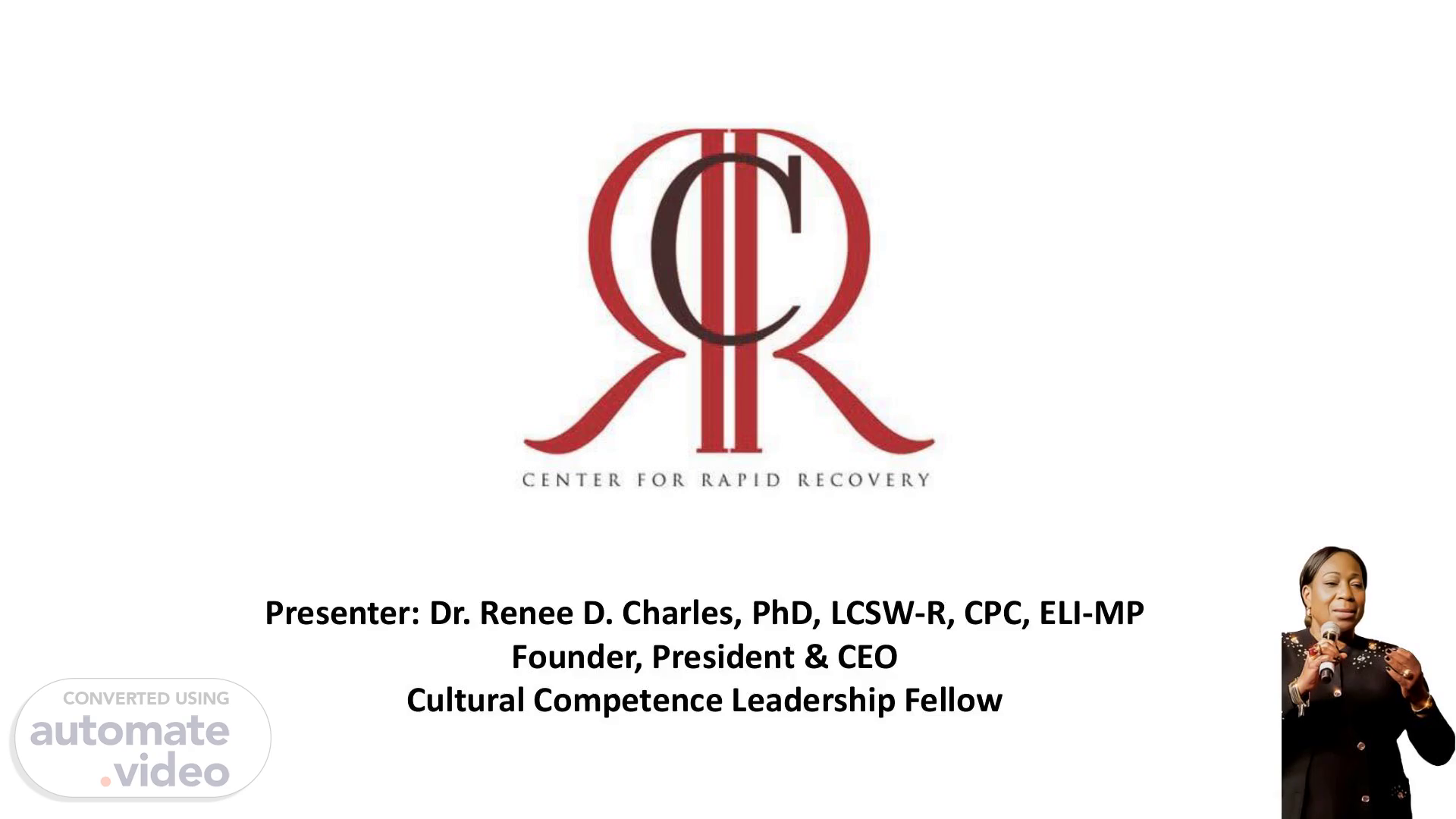
The Center for Rapid Recovery
Scene 1 (0s)
undefined. Presenter: Dr. Renee D. Charles, PhD, LCSW-R, CPC, ELI-MP Founder, President & CEO Cultural Competence Leadership Fellow.
Scene 2 (13s)
T he Center for RapiÆRecovery acreKtingdf Cultlirally (Competent care Sf.2 Greenwich Sfreef, 74en•psfeaÆ2Vf/ Cuffures, aeraav;ors SSS-RAPID13.
Scene 3 (22s)
undefined. SUBSTANCE ABUSE THE FACTS.
Scene 4 (28s)
Nearly 569,000 individuals in the U.S. used methamphetamines within the last month. What Meth Looks Like occc.
Scene 5 (37s)
Addiction is not a disease of willpower. It is a disease of instinct. It lives in the part of the brain that tells you to breathe..
Scene 6 (47s)
"Addiction is a brain disease and rno/e 'importantly, it is a disease of the brain motivational systems" Dr.eeorge Koob birecforw National Institute on Alcohol Abuse and Alcoholism.
Scene 7 (58s)
undefined. CRR OUTPATIENT ILLNESS IN RECOVERY BEHAVIORAL HEALTH PROGRAM (IRPBH).
Scene 8 (1m 6s)
RECOVERY.
Scene 9 (1m 11s)
NOtStA NOISSIÅ.
Scene 10 (1m 17s)
undefined. HEALTH DISPARITY The term health disparities refers to population-specific differences in the presence of disease, health outcomes, quality of health care and access to health care services that exist across racial and ethnic groups. Resource: (2002) IOM Report: Unequal Treatment: Confronting Racial and Ethnic Disparities in Healthcare.
Scene 11 (1m 44s)
[Audio] HEALTH DETERMINANTS Race, class and gender have been found to serve as important determinants of a person’s health and well-being status affecting his/her perception of illness, health seeking behaviors, accessibility to services and coping mechanisms. (UNAIDS/WHO, 2001)..
Scene 12 (2m 6s)
Vision long-term vievv¯, ho' successful businesc vision statement an aspirational de.
Scene 14 (2m 19s)
[Audio] Guiding Principles & Values Emerges from hope Is person-driven Strengths-based Age Independent Recognizes the wisdom of “lived experiences.” Occurs via many pathways Is holistic Is supported by peers, allies, advocates, and families Is nurtured through relationships and social networks Is cultural-based and influenced Addresses trauma Supports self-responsibility Empowers communities Is based on respect Is anchored in wellness- addressing a person’s emotional health, environmental well-being, financial satisfaction, intellectual creativity, occupational pursuits, physical activities, social engagement, and spiritual health.
Scene 16 (3m 12s)
[Audio] CULTURAL HEALTH BELIEF INTERVIEWING TOOLS.
Scene 19 (3m 30s)
[Audio] Description of Services.. Description of Services..
Scene 20 (3m 36s)
[Audio] Services that provide treatment and promote Habilitation Higher Ground Faith-Based Program for Persons with HIV/AIDS Individualized Residential Services for individuals with Intellectual Developmental Disabilities Medicaid Service Coordination for persons with Developmental Disabilities Day Habilitation Program for persons with Intellectual Developmental Disabilities (IDD) Bilingual Linkage Program for persons with IDD Mobile Intervention and Outreach Program for at-risk populations At Home Community Habilitation Program Spiritual Focus on Health and Wellness health promotion project Respite Services for persons with IDD..
Scene 21 (4m 23s)
[Audio] Services that provide treatment and promote Rehabilitation Individual Counseling Group Therapy-Substance Use. Anger Management, Parole and Probation, Living in Balance Peer Support Services Medication Assisted Treatment Faith Based Substance Services Dual Treatment Illness in Recovery Track Services for individuals engaged in the criminal justice system DWI/DUI based services Overdose Risk Assessments and Safety Planning Family Support Telemedicine.
Scene 22 (4m 53s)
RE:VIVE NOW NASAL SPUY.
Scene 23 (5m 0s)
[Audio] SERVICES THAT PROVIDE MEDICATION ASSISTED TREATMENT.
Scene 24 (5m 6s)
[Audio] Natural Morphine Codeine Fully synthetic Heroin Oxycodone Fentanyl Methadone Buprenorphine Opioids.
Scene 25 (5m 15s)
[Audio] Alcohol (88%) Marijuana (37%) Prescription opioids (15%) Benzodiazepines, such as Xanax (11%) Prescription stimulants, such as Adderall (10%) Cocaine (9%).
Scene 26 (5m 34s)
[Audio] CRR’S MAT GOAL. CRR’S MAT GOAL.
Scene 27 (5m 40s)
[Audio] TYPES OF MEDICATION AT CRR SUBOXONE. TYPES OF MEDICATION AT CRR SUBOXONE.
Scene 28 (5m 46s)
[Audio] TYPES OF MEDICATION AT CRR NALTREXONE OPIOID TREATMENT.
Scene 29 (5m 53s)
[Audio] TYPES OF MEDICATION AT CRR NALTREXONE ALCOHOL TREATMENT.
Scene 30 (5m 59s)
aLALILSN1 ONINIVHL IVN01SSagouc1.
Scene 32 (6m 11s)
[Audio] HOW TO GET HELP OR HELP OTHERS C ALL 516 424 4080 24 HOURS A DAY , 7 DAYS A WEEK , 365 DAYS A YEAR F OR A P HONE I NTAKE.
Scene 34 (6m 32s)
[Audio] Renee D. Charles, PhD 516 292- 6449 ext. 138 Ram@rapidrecovery.org Jane Cohen LMSW 516 2926449 ext. 145 Jcohen@rapidrecovery.org CONTACT INFORMATION.
Scene 35 (6m 58s)
VDD.